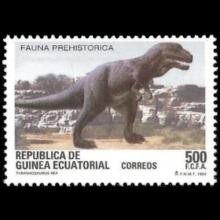NAMES
TAXONOMY
Germany
Issued:
Stamp:
Tyrannosaurus rex
Equatorial Guinea
Issued:
Stamp:
Tyrannosaurus rex
Germany
Issued:
Stamp:
Tyrannosaurus rex
Equatorial Guinea
Issued:
Stamp:
Tyrannosaurus rex
Germany
Issued:
Stamp:
Tyrannosaurus rex
Equatorial Guinea
Issued:
Stamp:
Tyrannosaurus rex
Genus species (Animalia): Tyrannosaurus rex
Tyrannosaurus (/tɪˌrænəˈsɔːrəs, taɪ-/) is a genus of large theropod dinosaur. The type species Tyrannosaurus rex (rex meaning 'king' in Latin), often shortened to T. rex or colloquially T-Rex, is one of the best represented theropods. It lived throughout what is now western North America, on what was then an island continent known as Laramidia. Tyrannosaurus had a much wider range than other tyrannosaurids. Fossils are found in a variety of rock formations dating to the latest Campanian-Maastrichtian ages of the Late Cretaceous period, 72.7 to 66 million years ago. It was the last known member of the tyrannosaurids and among the last non-avian dinosaurs to exist before the Cretaceous–Paleogene extinction event.
Like other tyrannosaurids, Tyrannosaurus was a bipedal carnivore with a massive skull balanced by a long, heavy tail. Relative to its large and powerful hind limbs, the forelimbs of Tyrannosaurus were short but unusually powerful for their size, and they had two clawed digits. The most complete specimen measures 12.3–12.4 m (40–41 ft) in length, but according to most modern estimates, Tyrannosaurus could have exceeded sizes of 13 m (43 ft) in length, 3.7–4 m (12–13 ft) in hip height, and 8.8 tonnes (8.7 long tons; 9.7 short tons) in mass. Although some other theropods might have rivaled or exceeded Tyrannosaurus in size, it is still among the largest known land predators, with its estimated bite force being the largest among all terrestrial animals. By far the largest carnivore in its environment, Tyrannosaurus rex was most likely an apex predator, preying upon hadrosaurs, juvenile armored herbivores like ceratopsians and ankylosaurs, and possibly sauropods. Some experts have suggested the dinosaur was primarily a scavenger. The question of whether Tyrannosaurus was an apex predator or a pure scavenger was among the longest debates in paleontology. Most paleontologists today accept that Tyrannosaurus was both an active predator and a scavenger.
Specimens of Tyrannosaurus rex include some that are nearly complete skeletons. Soft tissue and proteins have been reported in at least one of these specimens. The abundance of fossil material has allowed significant research into many aspects of its biology, including its life history and biomechanics. The feeding habits, physiology, and potential speed of Tyrannosaurus rex are a few subjects of debate. Its taxonomy is also controversial, as some scientists consider Tarbosaurus bataar from Asia to be a third Tyrannosaurus species, while others maintain Tarbosaurus is a separate genus. Several other genera of North American tyrannosaurids have also been synonymized with Tyrannosaurus. At present, two species of Tyrannosaurus are considered valid; the type species, T. rex, and the earlier and more recently discovered T. mcraeensis.
As the archetypal theropod, Tyrannosaurus has been one of the best-known dinosaurs since the early 20th century and has been featured in film, advertising, postal stamps, and many other media.
Description
Tyrannosaurus rex was one of the largest land carnivores of all time. One of its largest and the most complete specimens, nicknamed Sue (FMNH PR2081), is located at the Field Museum of Natural History in Chicago. Sue measured 12.3–12.4 m (40.4–40.7 ft) long, was 3.66–3.96 meters (12–13 ft) tall at the hips, and according to the most recent studies, using a variety of techniques, maximum body masses have been estimated approximately 8.4–8.46 metric tons (9.26–9.33 short tons). A specimen nicknamed Scotty (RSM P2523.8), located at the Royal Saskatchewan Museum, is reported to measure 13 m (43 ft) in length. Using a mass estimation technique that extrapolates from the circumference of the femur, Scotty was estimated as the largest known specimen at 8.87 metric tons (9.78 short tons) in body mass.
Not every adult Tyrannosaurus specimen recovered is as big. Historically average adult mass estimates have varied widely over the years, from as low as 4.5 metric tons (5.0 short tons), to more than 7.2 metric tons (7.9 short tons), with most modern estimates ranging between 5.4 and 8.0 metric tons (6.0 and 8.8 short tons).
A 2024 study estimated based on allometry that world-record sized T. rex specimens (1 in 100,000 individuals) may have reached lengths and weights exceeding 15 m (49 ft) and 15,000 kg (33,000 lb) respectively, though no individuals close to this size have ever been found. The study also found that there was little evidence of size-based sexual dimorphism in T. rex.
Reference: Wikipedia
Photo: Wikipedia Commons (ScottRobertAnselmo)



